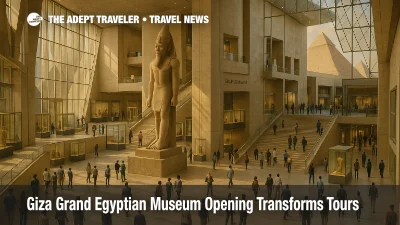Pyramids of Egypt
Embark on an unforgettable journey and travel to the Pyramids of Egypt, a remarkable destination that offers an unparalleled experience blending history, mystery, and awe-inspiring architectural brilliance. These ancient wonders, established over 4,500 years ago, have captured the human imagination for centuries and remain one of the most iconic symbols of human ingenuity and determination. When you travel to the Pyramids of Egypt, you'll be greeted by the majestic sight of the Great Pyramid of Giza, the Pyramid of Khafre, and the Pyramid of Menkaure, towering against the Egyptian skyline. These colossal structures were built as monumental tombs for the pharaohs and are steeped in rich historical significance, offering a glimpse into the lives and beliefs of ancient Egyptians. Imagine standing before these magnificent edifices, feeling the desert wind, and exploring the labyrinthine passages that once held secrets of the mummified pharaohs. The Pyramids of Egypt are surrounded by a landscape that includes the enigmatic Sphinx, a half-human, half-lion statue that adds to the enigmatic allure of the site. Additionally, the Pyramids' proximity to Cairo allows travelers to easily incorporate visits to world-class museums, bustling markets, and the vibrant culture of contemporary Egypt. As you travel to the Pyramids of Egypt, you'll not only witness these extraordinary feats of engineering but also immerse yourself in an atmosphere that bridges the ancient and the modern, providing a truly enriching travel experience. Whether you're a history enthusiast, an architectural aficionado, or simply seeking an extraordinary adventure, the Pyramids of Egypt promise an experience that is both timeless and transformative. Don't miss the chance to travel to the Pyramids of Egypt and create memories that will last a lifetime.
The History of Pyramids of Egypt
Travel to the Pyramids of Egypt and immerse yourself in the wonder of one of humanity’s most iconic achievements. The history of the Pyramids of Egypt is more than just an ancient architectural marvel; it is a journey through time that tells the story of civilization, divine kingship, and human ingenuity. Constructed during Egypt's Old Kingdom, the Pyramids, especially the Great Pyramids of Giza, are a testament to the ambition and spirituality that characterized this ancient society. Your journey to the Pyramids of Egypt will reveal layers of history that have fascinated scholars and travelers for millennia, making it a must-see destination for any history enthusiast.
Origins in the Old Kingdom
The construction of the Pyramids of Egypt dates back to approximately 2580 - 2560 BC, during the Fourth Dynasty of the Old Kingdom. King Djoser’s Step Pyramid at Saqqara, designed by the architect Imhotep, marked a significant leap in architectural innovation. This pyramid set the precedent for the true pyramids that followed, with the Great Pyramid of Giza being the most renowned. The Pyramids were not merely grand tombs; they were constructed to ensure the pharaohs' souls could ascend to the heavens and join the gods, highlighting the strong connection between architecture, religion, and the afterlife in ancient Egyptian culture.
The Construction Process
One of the most compelling aspects of traveling to the Pyramids of Egypt is witnessing firsthand the ingenuity involved in their construction. These colossal structures were built using millions of limestone and granite blocks, some weighing as much as 80 tons. The precise alignment of the Pyramids with the cardinal points and their sophisticated engineering still baffle modern scientists and engineers. While the labor force was initially thought to have been composed of slaves, recent discoveries suggest that a skilled workforce of laborers who lived in nearby workers' villages carried out the construction. Their expertise and dedication are evident in the enduring might of these monuments, making a trip to the Pyramids of Egypt a testament to human perseverance and technological prowess.
Discoveries and Mysteries
Travel to the Pyramids of Egypt and uncover the myriad mysteries that continue to intrigue historians and archaeologists. Over the centuries, the Pyramids have been a subject of extensive research and discovery. Intricate burial chambers, enigmatic hieroglyphs, and mysterious voids discovered using advanced technology like muon radiography add layers of intrigue to the narrative of the Pyramids. The Great Pyramid's alignment with celestial points and its internal architecture resembling a labyrinthine maze hint at a vast reservoir of knowledge yet to be entirely deciphered. These ongoing discoveries provide a dynamic, evolving experience for visitors eager to delve into Egypt's rich and storied past.
By choosing to travel to the Pyramids of Egypt, you are not just visiting a world-renowned site; you are stepping into a time capsule that spans over 4,500 years. Each stone, each chamber, and each hieroglyph speaks of a civilization's quest for immortality and divine harmony. This journey offers a unique opportunity to connect with an era that has shaped human history in profound ways. Whether you are an avid history buff, an archaeology enthusiast, or a curious traveler, the Pyramids of Egypt promise an unforgettable experience that transcends time and space.
The Culture of Pyramids of Egypt
The Pyramids of Egypt are much more than awe-inspiring ancient structures; they are a profound testament to the rich tapestry of the Egyptian culture and its people. When you choose to travel to the Pyramids of Egypt, you are embarking on a journey that spans millennia, touching on the ancient ways of life that have influenced the modern ethos of Egypt. This incredible destination is a cross-generational marvel, drawing people from all over the world to revel in its architectural genius and cultural significance.
One of the most compelling reasons to travel to the Pyramids of Egypt is to experience the unique blend of antiquity and vibrancy that the Egyptian people bring to life. The locals are known for their warm hospitality and deep sense of pride in their heritage. From the bustling markets of Cairo to the serene banks of the Nile, you will always find Egyptians eager to share their stories, traditions, and intricate crafts. This immersion allows travelers to see beyond the pyramids as mere tourist attractions and appreciate them as symbols of enduring cultural identity.
The Majestic Monuments and their Symbolism
The Pyramids of Egypt, most notably the iconic structures at Giza, are imbued with symbolism and religious significance that reflect the ancient Egyptians' sophisticated understanding of the world around them. These grand monuments were built as tombs for pharaohs, with each stone bearing witness to the Egyptians' architectural prowess and spiritual beliefs. When you stand before a pyramid, you are not just gazing upon an ancient structure, but delving into the mysteries of an era where the celestial and terrestrial were intricately connected. The alignment and precision in their construction continue to baffle and impress historians and architects alike.
Engage with Egyptian Traditions and Heritage
Travel to the Pyramids of Egypt and you will find yourself in the midst of an active and engaging cultural landscape. Take part in traditional Egyptian activities such as camel riding around the pyramids or attending local festivals that celebrate the rich history of the nation. The sound of traditional music flows through the air, and the taste of authentic Egyptian cuisine, with its rich spices and flavors, is an adventure in its own right. Participating in these customs offers a deeper understanding of the cultural fabric that has shaped the Egyptian way of life through generations.
Ultimately, when you travel to the Pyramids of Egypt, you are immersing yourself in a story that spans thousands of years. The grandeur of the pyramids is complemented by the lived experiences of the people who continue to uphold Egypt's rich cultural legacy. From engaging with local traditions to marveling at the architectural wonders, a visit to the Pyramids of Egypt is an unparalleled cultural experience that should not be missed.
The Food of Pyramids of Egypt
When you travel to Pyramids of Egypt, you're not only stepping into a world of historical wonder but also diving into a culinary journey that tantalizes your taste buds. The ancient land of Egypt doesn't only offer monumental marvels like the Great Pyramids and the Sphinx; it promises a dining experience steeped in rich flavors and aromatic spices. Imagine savoring delectable dishes that have been perfected over centuries of dynasties, blending ancient recipes with modern gourmet twists. From street food stalls to elegant restaurants, your palate will dance with exotic tastes as you explore the vibrant culinary landscape this country has to offer.
The bustling streets near the Pyramids of Egypt are lined with an array of street food vendors, each offering a unique taste of traditional Egyptian fare. As you wander, you'll be enticed by the smell of freshly baked bread, particularly the iconic "baladi" bread, which is a staple in Egyptian cuisine. Paired with flavorful dips like "dukkah" or "tahini," these simple yet hearty snacks provide an authentic introduction to the local flavors. Don't miss out on trying "koshari," a beloved street food dish made with rice, lentils, chickpeas, and pasta, all topped with a spicy tomato sauce and crispy onions. This dish is not only filling but also embodies the multicultural influences that have shaped Egyptian cuisine over millennia.
For those seeking a more immersive dining experience, numerous restaurants around the Pyramids of Egypt offer exquisite meals that cater to all tastes. Imagine dining under the stars with the ancient pyramids as your backdrop, an experience that combines breathtaking views with decadent flavors. Menus often feature classics like "molokhia," a green soup made from finely chopped jute leaves, and "fattah," a festive dish consisting of rice, meat, and crispy bread soaked in broth, often served during special occasions. Whether you opt for a casual eatery or a high-end restaurant, the emphasis on fresh ingredients and spices such as cumin, coriander, and cinnamon ensures an unforgettable culinary adventure.
Finally, no travel to Pyramids of Egypt is complete without indulging in some local desserts and beverages. Egyptian sweets like "baklava" and "kunafa" are a treat for those with a sweet tooth, showcasing the perfect blend of nuts, honey, and pastry. For a refreshing finish, sip on a glass of "karkadeh" (hibiscus tea) or try a cup of traditional "ahwa" (Egyptian coffee), which offers a rich, bold flavor that perfectly complements the sweetness of your dessert. Whether you're dining in a cozy cafe or a grand restaurant, these time-honored treats provide a delightful end to your Egyptian culinary journey.
What to See and Do in Pyramids of Egypt
When you travel to Pyramids of Egypt, you embark on a journey through time, immersed in the ancient wonders of world-renowned architectural marvels. Here’s a detailed guide outlining ten essential activities every traveler must do to make the most of their visit to the Pyramids of Egypt in Giza, Egypt.
1. Explore the Great Pyramid of Giza
The Great Pyramid of Giza, often referred to simply as the Pyramid of Khufu, is the most iconic monument among the Pyramids of Egypt. To fully appreciate this wonder, embark on a guided tour that takes you inside. Note the intricate construction and feel the ancient stones. It is advisable to book tickets in advance due to the high demand and limited availability.
2. Visit the Pyramid of Khafre
The Pyramid of Khafre, often mistaken as the largest due to its higher elevation, offers a unique perspective of the Pyramids of Egypt. Pay close attention to the adjacent Valley Temple and the causeway that connects to the Sphinx. The layers of history and the engineering brilliance will fascinate any visitor.
3. Marvel at the Sphinx
Standing guard over the Pyramids of Egypt, the Great Sphinx of Giza is a must-see. The Sphinx's enigmatic expression is the subject of many legends and mysteries. Make sure you capture photographs from various angles, showcasing the monumental scale and the artistry embedded in its limestone structure.
4. Take a Camel Ride
No travel to Pyramids of Egypt is complete without a quintessential camel ride. Traverse the Giza Plateau atop a camel and experience the desert landscape as the ancient Egyptians might have. This ride offers a unique vantage point for pictures and a serene way to appreciate the vastness of the Pyramids.
5. Visit the Solar Boat Museum
Located near the Great Pyramid of Giza, the Solar Boat Museum houses the reconstructed Khufu ship, an ancient vessel buried near the pyramid to transport Pharaoh Khufu’s spirit to the afterlife. The detailed craftsmanship of the boat provides vital insight into the naval technology of ancient Egypt.
6. Sunset Views Over the Pyramids
To capture the mystical allure of the Pyramids of Egypt, stay until sunset. The pyramids silhouetted against the setting sun create a picturesque and unforgettable viewpoint. The hues of the sky provide perfect lighting for photographers and a serene end to a day of exploration.
7. Light and Sound Show
In the evening, attend the renowned Light and Sound Show at the Pyramids of Egypt. Storytelling combined with dramatic lighting brings to life the history and legends of the pyramids. The narrative, available in multiple languages, makes the ancient history accessible and engaging for all visitors.
8. Pyramids of Dahshur
About 40 km south of Giza, in Dahshur, Egypt, you can explore two lesser-known pyramids: The Bent Pyramid and the Red Pyramid. Both offer a less crowded experience compared to Giza's monuments. Particularly intriguing is the Bent Pyramid, with its unusual change in angle midway, showcasing an evolutionary step in pyramid construction.
9. Saqqara Necropolis
A short travel from Giza, the Saqqara Necropolis in Saqqara, Egypt is home to the Step Pyramid of Djoser, the earliest large-scale cut stone construction. Besides the step pyramid, there are dozens of tombs and an expanse of ancient ruins, providing a comprehensive look into mortuary practices and architectural advancements predating the Giza pyramids.
10. Visit the Egyptian Museum in Cairo, Egypt
A trip to the Pyramids of Egypt should be complemented with a visit to the Egyptian Museum in Cairo. Here, you'll find countless artifacts recovered from the pyramid complexes, including treasures from King Tutankhamun’s tomb. These items provide deeper insight into the daily lives, beliefs, and artistry of ancient Egyptians.
Travel to Pyramids of Egypt is an expedition through millennia, offering unparalleled glimpses into one of the world's earliest and most fascinating civilizations. Each activity provides a unique experience, deepening your understanding and appreciation of these ancient wonders.
Why You Should Travel to Pyramids of Egypt
The Pyramids of Egypt have captivated the hearts and minds of travelers for centuries, standing as timeless symbols of ambition, ingenuity, and mystery. One of the primary reasons travelers are drawn to the Pyramids of Egypt is their sheer historical significance. Built during the Old Kingdom, these monumental structures were originally erected as tombs for pharaohs and are steeped in legend and lore. The most famous among them, the Great Pyramid of Giza, is the only one of the Seven Wonders of the Ancient World still in existence. Travelers often find themselves mesmerized by the architectural genius it took to construct these colossal edifices without modern machinery, adding layers of wonder and admiration with each step they take on this ancient ground.
Another compelling reason why travelers love to travel to Pyramids of Egypt is the cultural and educational experience it provides. Visiting these awe-inspiring monuments offers a glimpse into ancient Egyptian civilization, known for its rich mythology, advanced engineering, and remarkable artistic endeavors. The Pyramids of Egypt are not just relics of the past but also gateways to understanding the socio-political and religious paradigms of ancient times. Guided tours often bring to life the stories of prominent pharaohs, the significance of hieroglyphic writings, and the intriguing burial rituals that encompass the pyramids. For travelers, these narratives offer a profound connection to a civilization that significantly shaped human history.
The surrounding landscape also adds to the allure of travel to Pyramids of Egypt. Located near Cairo, the Giza Plateau provides stunning vistas of sprawling desert sands and towering pyramids that beckon for exploration. The nearby Sphinx, an enigmatic statue with the body of a lion and the head of a pharaoh, further enriches the experience. Moreover, the area is home to various museums, such as the Egyptian Museum, which houses treasures unearthed from the pyramid complexes. These cultural repositories offer additional insight into Egyptian heritage and complement the outdoor historical exploration with indoor scholarly enrichment, making the Pyramids of Egypt an irresistible travel destination.
Why You Must Travel to Pyramids of Egypt
Your journey to the Pyramids of Egypt will be an unforgettable adventure, blending breathtaking historical marvels with a deeply enriching cultural experience. Imagine standing in the shadows of colossal structures that have stood the test of time, their grandeur unchanged since antiquity. Traveling to the Pyramids of Egypt is not merely a trip but a transformative voyage that allows you to walk in the footsteps of ancient kings and queens. Whether you're an avid historian, a lover of architecture, or simply someone in search of a unique adventure, the Pyramids of Egypt will leave you in awe and provide memories that last a lifetime. Don't miss the chance to experience one of the most storied places on Earth, where every stone whispers tales of a glorious past.
Tips & Tricks for Traveling in Pyramids of Egypt
When you plan your next adventure to the Pyramids of Egypt, it's essential to have a well-laid strategy. Here are some invaluable tips and tricks to enhance your experience and make your travel to the Pyramids of Egypt both seamless and enjoyable.
Choose the Right Time to Travel
The best time to travel to the Pyramids of Egypt is during the cooler months from October to April. The weather is more bearable, allowing you to explore the historic wonders without the discomfort caused by Egypt's scorching summer heat.
Book Your Tickets in Advance
Pre-booking your tickets to the Pyramids of Egypt can save you a significant amount of time and avoid potential disappointments. Given the Pyramids' popularity, entrance tickets can sell out, especially during peak seasons.
Hire a Local Guide
Enhance your visit by hiring a local guide who can provide insightful stories, historical context, and unknown facts about the Pyramids of Egypt. Guides are often available at the entrance or can be booked through travel agencies.
Start Early in the Day
To avoid the crowds and escape the midday heat, begin your tour early in the morning. This early start ensures a more serene and intimate experience, allowing you to appreciate the majestic structures of the Pyramids without distractions.
Wear Comfortable Clothing
Considering the walking and climbing involved, wear comfortable and lightweight clothing. Breathable fabrics, sturdy walking shoes, and a hat or scarf for sun protection are highly recommended.
Stay Hydrated
Carry a sufficient quantity of water to stay hydrated. While there are vendors around the area, it’s ideal to have your own supply to avoid inflated prices and ensure you are well-prepared for the heat.
Respect the Local Customs
When you travel to the Pyramids of Egypt, it's crucial to respect local customs and traditions. Dress modestly, avoid inappropriate behavior, and always ask for permission before snapping photographs of people.
Utilize Tourist Apps
There are several mobile apps aimed at enhancing your travel experience. Apps can provide virtual tours, detailed guides, and historical information about the Pyramids of Egypt, making your exploration more enriching and informative.
Keep an Eye on Your Belongings
Be vigilant about your personal items. Crowded tourist spots can often be a hotspot for pickpocketing. Using a money belt or a secure bag can be a prudent measure to safeguard your valuables.
Engage with the Locals
Interacting with locals can provide a deeper understanding of Egyptian culture and history. Don't hesitate to engage in friendly conversations—they can offer tips, recommend hidden gems, and enhance your overall travel experience.
Your next adventure to the Pyramids of Egypt can be a memorable and fulfilling one if you follow these tips. By planning ahead and adopting these practical strategies, you will maximize your experience and truly savor the historical splendor that awaits. Enjoy your journey into ancient history and marvel at one of the world's most iconic destinations.
Other Places You Might Like
If you have a passion for the mystique and grandeur associated with the Pyramids of Egypt, then there's a plethora of other archaeological and historical marvels around the world that you should add to your travel bucket list. These destinations offer an intriguing glimpse into ancient civilizations and their awe-inspiring architectural feats. Let's explore some remarkable places that evoke similar awe and fascination as the Pyramids of Egypt.
Chichen Itza - Yucatán, Mexico
Nestled in the heart of the Yucatán Peninsula, Chichen Itza is one of the most stunning remnants of the ancient Mayan civilization. El Castillo, the temple pyramid dedicated to the Mayan god Kukulkan, stands as a testament to the architectural prowess and astronomical knowledge of the Mayans. Travelers who have marveled at the Pyramids of Egypt will find Chichen Itza equally captivating for its historical significance and intricate stonework. The site also offers a glimpse into the Mayan way of life through its ball courts, temples, and ritual sites.
Machu Picchu - Cusco Region, Peru
Perched high in the Andes Mountains, Machu Picchu is a symbol of the Inca Empire's grandeur and ingenuity. Unlike the Pyramids of Egypt, which are situated on flat desert land, Machu Picchu's vertiginous location imbues it with a unique mystical aura. The ancient city, with its terraced fields, plazas, and imposing stone constructions, provides a breathtaking panorama that history buffs and architectural aficionados will deeply appreciate. When you travel to Pyramids of Egypt, adding Machu Picchu to your travel itinerary will give you a broader perspective on the marvels of ancient engineering.
Petra - Ma'an Governorate, Jordan
Known as the "Rose City" due to the hue of the stone from which it is carved, Petra is another wonder for those who have a taste for ancient architectural brilliance. The city is accessed through a narrow gorge called the Siq, leading to the stunning Al-Khazneh (The Treasury). Just as the Pyramids of Egypt captivate with their scale and precision, Petra fascinates with its detailed carvings and sheer size. This archaeological paradise offers insights into the Nabatean civilization and its complex water conduit system.
Angkor Wat - Siem Reap, Cambodia
Travelers who have been enthralled by the Pyramids of Egypt will find Angkor Wat in Cambodia equally mesmerizing. This UNESCO World Heritage site, originally a Hindu temple and later converted to a Buddhist monastery, stands as the largest religious monument in the world. The temple complex is adorned with intricate bas-reliefs and Devatas (guardian deities) that tell stories of mythological and historical significance. Its grandeur and spiritual ambiance make Angkor Wat a must-visit for those inspired by ancient wonders.
Teotihuacan - State of Mexico, Mexico
Another Mesoamerican marvel, Teotihuacan, is famed for its impressive pyramids, particularly the Pyramid of the Sun and the Pyramid of the Moon. These ancient structures bear a striking resemblance to the Pyramids of Egypt in their monumental scale and mysterious origins. The Avenue of the Dead, a grand road that traverses the city, offers additional layers of wonder with its temples and palatial residences. A visit to Teotihuacan provides a deep dive into the enigmas of the pre-Columbian world and their architectural ingenuity.
Tikal - Petén Basin, Guatemala
Tikal, nestled in the lush jungles of northern Guatemala, is one of the largest archaeological sites of the ancient Maya civilization. Its towering pyramids rise above the canopy, offering panoramic views of the surrounding forest. The Great Jaguar Temple is particularly striking and akin to the awe-inspiring presence of the Pyramids of Egypt. Exploring Tikal allows you to immerse yourself in Mayan history, culture, and the natural beauty that surrounds this sacred city.
The Acropolis - Athens, Greece
For those who have admired the Pyramids of Egypt, the Acropolis in Athens offers another fascinating dive into ancient architectural and cultural achievements. The Parthenon, dedicated to the goddess Athena, is an epitome of ancient Greek artistry and engineering. Walking through the ruins of the Acropolis, visitors can feel the historical weight and cultural significance that shaped Western civilization. The Acropolis Museum nearby further enriches the experience with its extensive collection of Greek artifacts.
Exploring these astounding works of ancient architecture provides a broader understanding of human history's innovative and artistic achievements. Each destination offers a unique perspective and a rich tapestry of stories waiting to be discovered.
Egypt Nile E-Bike Tour Launches Feb 2026 Departures

Aden Airport Closure Disrupts Yemen Flights

Storm Byron Israel Flooding Risk For December Trips

Red Sea Piracy And Slow Suez Return Keep Cruises Wary

Nile Seray Nile Cruises Open For October 2026

Rafah Crossing Reopening Lets Gazans Exit To Egypt

2027 Mediterranean Season Adds Egypt Yacht Voyages

Red Sea Security Reroutes 2026 World Cruises

Red Sea Tensions Delay Saudi Arabia Cruise Season

Giza Grand Egyptian Museum Opening Transforms Tours

Egypt Nile Riverboat Launch Adds Luxury Ship In 2028

Regional Airline Cancellations Hit African Hubs

Oman Air Grounds Jets As Supply Chain Crunch Hits Schedules

Boat Bike Tours Launches E-Bike Nile Itinerary in 2026

Minor Hotels, SUNRISE ink Egypt joint venture for 50 hotels

EgyptTours.com launches new private Egypt tours for 2025-2026

Egypt lifts relics from sunken city Alexandria

Viking 2026 Cruise Bookings Hit 55%, Fleet Grows

Conflicts Redraw Airspace, Forcing Costly Detours

EF Ultimate Break Debuts BookTok Travel Tours

GCC Grand Tours Visa Simplifies Gulf Travel for U.S. Passport Holders

Gulf Air Returns to U.S. With Nonstop Bahrain-New York Flights

United Airlines Restarts Tel Aviv Flights July 21

Smithsonian Journeys Unveils 2026-27 Eclipse Tours and River Cruises

Waldorf Astoria Nile River Cruise Sets Sail in 2026

